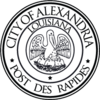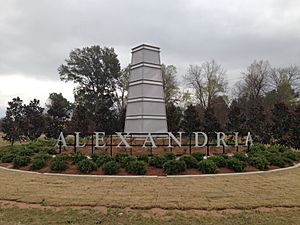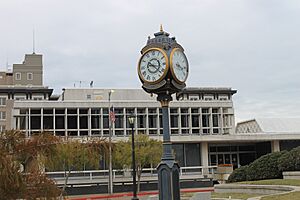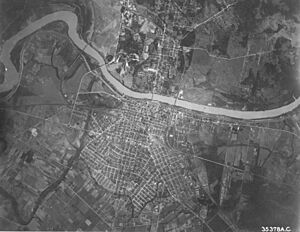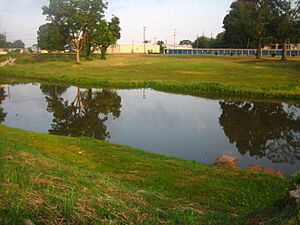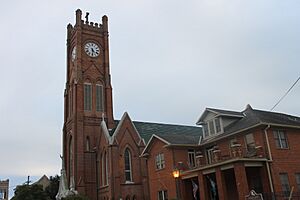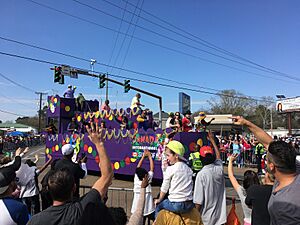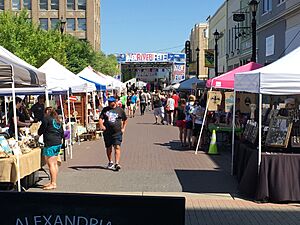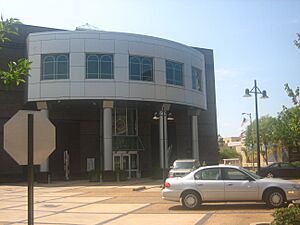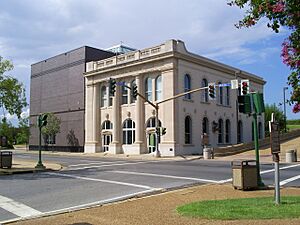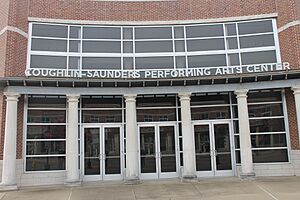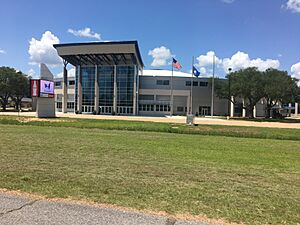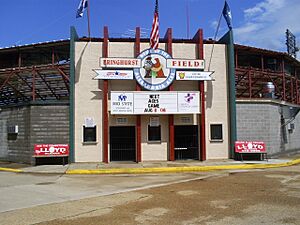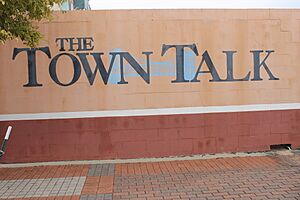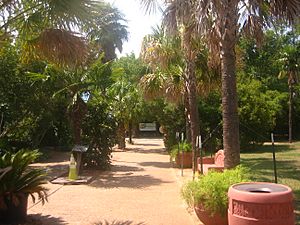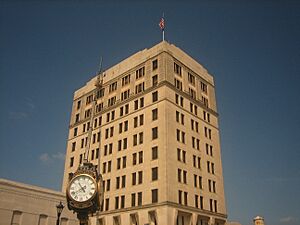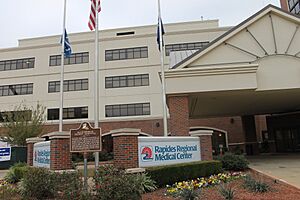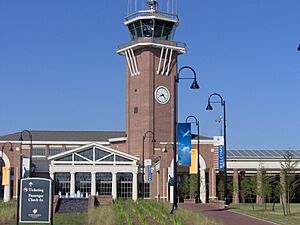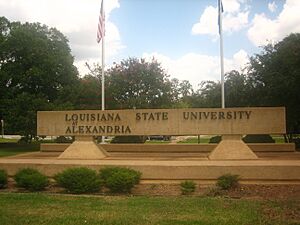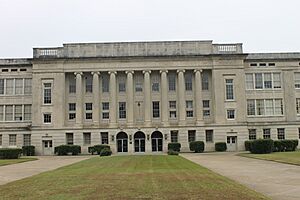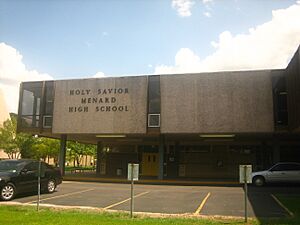Alexandria, Louisiana facts for kids
Quick facts for kids
Alexandria
|
|||
|---|---|---|---|
| City of Alexandria | |||
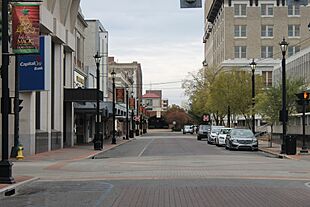
Downtown
|
|||
|
|||
| Nickname(s):
Alex (typically pronounced Ellic)
|
|||
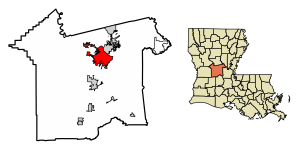
Location of Alexandria in Rapides Parish, Louisiana.
|
|||
| Country | United States | ||
| State | Louisiana | ||
| Parish | Rapides | ||
| Founded | 1785 | ||
| Incorporated (town) | 1818 | ||
| City Charter | 1882 | ||
| Area | |||
| • City | 29.18 sq mi (75.58 km2) | ||
| • Land | 28.49 sq mi (73.79 km2) | ||
| • Water | 0.69 sq mi (1.79 km2) | ||
| Elevation | 75 ft (23 m) | ||
| Population
(2020)
|
|||
| • City | 45,275 | ||
| • Rank | RA: 1st LA: 9th |
||
| • Density | 1,589.10/sq mi (613.56/km2) | ||
| • Metro | 153,922 | ||
| Time zone | UTC−6 (CST) | ||
| • Summer (DST) | UTC−5 (CDT) | ||
| ZIP codes |
71301-03, 06–07, 09, 11, 15
|
||
| Area code(s) | 318 | ||
| Phone Number Prefixes | 201, 290, 308, 318, 420, 427, 441–443, 445, 448, 449, 473, 483, 484, 487, 542, 561, 619, 767, 769, 787, 880 | ||
Alexandria is a city in Louisiana, United States. It is the ninth-largest city in the state. Alexandria is also the main city in Rapides Parish. It sits on the south bank of the Red River, right in the middle of Louisiana. The city is the center of the Alexandria metropolitan area, which includes Rapides and Grant parishes. Its neighbor is Pineville. In 2020, about 45,275 people lived in Alexandria.
Contents
- Discovering Alexandria's Past
- Exploring Alexandria's Location and Weather
- Who Lives in Alexandria?
- Places of Worship in Alexandria
- Fun Events and Festivals
- Museums and History
- Performing Arts Scene
- Sports and Recreation
- Notable People from Alexandria
- Media in Alexandria
- Parks and Outdoor Fun
- Other Cool Places to Visit
- Military Presence
- Alexandria's Economy
- Learning in Alexandria
- Getting Around Alexandria
- Nearby Cities and Towns
- Images for kids
- See also
Discovering Alexandria's Past
Alexandria started as a small community along the Red River. It supported a French trading post called Post du Rapides. The area grew as a meeting place for traders, Caddo people, and merchants. It connected the southern parts of Louisiana to the El Camino Real and the older settlement of Natchitoches.
Alexander Fulton, a businessman from Pennsylvania, received land here in 1762. The first organized settlement began in the 1780s. In 1805, Fulton and his partner Thomas Harris Maddox planned the town. They named it Alexandria to honor Fulton. The city became an official town in 1818 and got its city charter in 1832.
Exploring Alexandria's Location and Weather
Alexandria is located at 31°17′34″N 92°27′33″W / 31.29278°N 92.45917°W. It is about 75 feet (23 meters) above sea level.
The city covers about 29.18 square miles (75.58 square kilometers). Most of this area is land, with a small part being water.
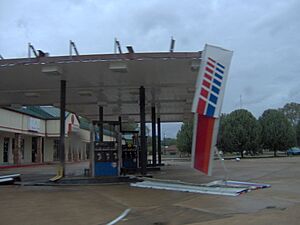
Alexandria is on a flat plain in the middle of Louisiana's Longleaf Pine forests. These forests have both pine and hardwood trees. Many small bayous, like Bayou Rapides, flow through the city. Farmers in the area grow cotton, sugar, alfalfa, and vegetables.
The climate here is humid subtropical. This means summers are hot and humid. Winters are usually mild, but sometimes it gets cold. The area gets a lot of rain all year. Thunderstorms can happen at any time, especially in spring. Snow is rare.
Sometimes, tropical storms and hurricanes affect Alexandria. They usually don't cause severe damage like they do closer to the coast. In 2005, Hurricane Rita caused power outages and roof damage. In 2008, Hurricane Gustav caused widespread flooding and knocked down trees.
Who Lives in Alexandria?
| Historical population | |||
|---|---|---|---|
| Census | Pop. | %± | |
| 1840 | 814 | — | |
| 1850 | 672 | −17.4% | |
| 1860 | 1,461 | 117.4% | |
| 1870 | 1,218 | −16.6% | |
| 1880 | 1,800 | 47.8% | |
| 1890 | 2,861 | 58.9% | |
| 1900 | 5,648 | 97.4% | |
| 1910 | 11,213 | 98.5% | |
| 1920 | 17,510 | 56.2% | |
| 1930 | 23,025 | 31.5% | |
| 1940 | 27,066 | 17.6% | |
| 1950 | 34,913 | 29.0% | |
| 1960 | 40,279 | 15.4% | |
| 1970 | 41,811 | 3.8% | |
| 1980 | 51,648 | 23.5% | |
| 1990 | 49,188 | −4.8% | |
| 2000 | 46,342 | −5.8% | |
| 2010 | 47,723 | 3.0% | |
| 2020 | 45,275 | −5.1% | |
| U.S. Decennial Census | |||
In 2020, Alexandria had 45,275 people living in the city. There were 17,920 households and 10,933 families.
A Look at the 2020 Census
| Race | Number | Percentage |
|---|---|---|
| Black or African American (non-Hispanic) | 24,745 | 54.65% |
| White (non-Hispanic) | 16,537 | 36.53% |
| Other/Mixed | 1,571 | 3.47% |
| Hispanic or Latino | 1,275 | 2.82% |
| Asian | 977 | 2.16% |
| Native American | 156 | 0.34% |
| Pacific Islander | 14 | 0.03% |
The 2020 census showed that 54.65% of the people were Black or African American. 36.53% were White. Other groups made up smaller percentages.
What the 2010 Census Showed
In 2010, there were 47,723 people in Alexandria. About 31.9% of households had children under 18. The average household had 2.50 people.
The population was spread out by age. 28.1% were under 18. 15.1% were 65 or older. The average age was 36 years.
Places of Worship in Alexandria
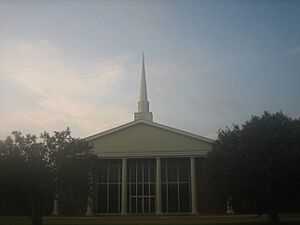
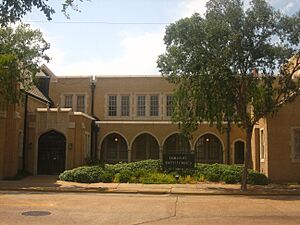
Like many southern cities, Alexandria has many Southern Baptist churches. Large ones include Emmanuel Baptist Church and Calvary Baptist Church. Alexandria is also the main office for the Louisiana Baptist Convention. Many Methodists, Presbyterians, Episcopalians, and Pentecostals live here too.
There is a large Catholic population. This is because many Acadian French people live in and around Alexandria. Alexandria is the main office for the Diocese of Alexandria.
Alexandria also has a small but active Jewish community. It started in the mid-1800s. Jewish people have held important jobs in the city. There are two synagogues in Alexandria: Congregation Gemiluth Chassodim (Reform) and B'nai Israel Traditional Synagogue (Conservative).
Fun Events and Festivals
Mardi Gras Celebrations
Even though Alexandria is not in the main Cajun area, it celebrates Mardi Gras as an official holiday. The yearly Mardi Gras Krewes Parade is a big event. It happens on the Sunday before Mardi Gras. It's a family-friendly event with over 20 New Orleans-style floats. You can also see high school and college marching bands.
Other parades include:
- The College Cheerleaders & Classic Cars Parade on the Friday before Mardi Gras.
- The Children's Parade on the Saturday before Mardi Gras.
- The Krewe of Provine Parade on Fat Tuesday.
The Alexandria Mardi Gras Association (AMGA) organizes all these events. The main Krewe Parade can attract up to 150,000 people!
Alex River Fête: A Spring Festival
This yearly three-day festival happens in downtown Alexandria in late April or early May. It started in 2013. The festival includes the Louisiana Dragon Boat Races, which used to be a separate event. You can also find:
- Dinner on the Bricks
- The ArtWalk (now Art Fête)
- Many booths with food and live music
- The Kids Fête and Classic Car Fête
Alex Winter Fête: A Winter Wonderland
This festival takes place in early December in downtown Alexandria. It started in 2015. The first year, it attracted twice as many people as expected. Like the Alex River Fête, it has booths, food, and live music. It also features an ice rink! In 2017, the Alex Winter Fête was named Festival of the Year by the Louisiana Travel Promotion Association.
Museums and History
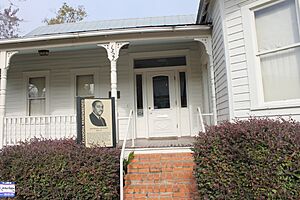
The Alexandria Museum of Art opened in 1977. It is in a historic Rapides Bank Building from 1898. The museum expanded in 1998. It also works with Louisiana State University of Alexandria (LSUA). It hosts classes, concerts, lectures, and other community events.
The Louisiana History Museum is downtown in the old library building. It shows the history of Louisiana, focusing on the central part of the state. You can learn about Native Americans, geography, and the impact of wars.
Other museums include the T.R.E.E. House Children's Museum and the Arna Bontemps African American Museum.
The Kent Plantation House is the oldest building still standing in Central Louisiana. It was built by 1800. It is one of only two buildings in the city that survived the burning of 1864 during the Civil War. You can take tours of the house and its nine outbuildings. These include a sugar mill, blacksmith shop, and slave cabins.
Performing Arts Scene
Alexandria's performing arts are mainly in the Cultural Arts District downtown. There are three main places for performances:
- Coughlin-Saunders Performing Arts Center
- The Hearn Stage
- The Riverfront Amphitheater
The Coughlin-Saunders Performing Arts Center is home to the Rapides Symphony Orchestra. This orchestra has been performing since 1968. The center also hosts other groups, like the Red River Chorale.
The Hearn Stage is a smaller theater for different kinds of shows. The Arts Council manages both the Coughlin-Saunders Center and the Hearn Stage.
The Riverfront Amphitheater hosts a "Jazz on the River" music festival every April. The Rapides Symphony also has a fall concert there. The amphitheater has also welcomed musical guests during the Dragonboat Races.
You can also enjoy free outdoor concerts called Downtown Rocks in Fulton Park.
Sports and Recreation
Alexandria used to have a summer college baseball team called the Alexandria Aces. They played at Bringhurst Field. The stadium got old and was eventually torn down. Now, it's a green space for the public.
The city also had a minor league ice hockey team, the Alexandria Warthogs. They played at the Rapides Parish Coliseum. A professional indoor football team, the Louisiana Rangers, also played there.
Soccer is growing in Alexandria. The Crossroads Soccer Association has youth teams that have won state championships. Central Louisiana FC is the city's first amateur soccer team. They play in the Gulf Coast Premier League.
Alexandria has several golf courses, including Bringhurst Golf Course, known as "the nation's oldest par-three course."
Notable People from Alexandria
- Anna Margaret – singer, actress
- Emmanuel Arceneaux – Canadian football player
- Jay Aldrich – Major League Baseball player
- Arna Bontemps – African American poet
- Bubby Brister – Quarterback for several NFL teams
- D. J. Chark - American football player
- Demar Dotson - American football player
- Eric Johanson – blues rock musician
- Josh Johnson – comedian
- John Leglue - NFL player
- Juan Pierre – Major League Baseball player
- Jalen Richard - NFL player
- Russ Springer – Major League Baseball player for 18 years
- William Tecumseh Sherman – first superintendent of Louisiana State Seminary (later LSU)
- Muse Watson – actor
- Rebecca Wells – author, actor, and playwright
Media in Alexandria
Local Newspapers
The Alexandria Town Talk is a daily newspaper. It started on March 17, 1883. It serves Alexandria-Pineville and the thirteen parishes in central Louisiana. The Gannett Company owns the newspaper now.
Television Channels
Alexandria has several local TV stations:
- KALB-TV (NBC / CBS/ The CW)
- WNTZ (Fox)
- KLAX-TV (ABC)
- KLPA (PBS/LPB)
- KBCA (Heroes & Icons)
KALB is the oldest TV station in central Louisiana.
Radio Stations
Parks and Outdoor Fun
Alexandria Zoological Park
The Alexandria Zoological Park is a 33-acre (13 ha) zoo. It first opened in 1926. The zoo has about 500 animals. It has an award-winning Louisiana Habitat exhibit. The zoo helps with conservation efforts for different animal species.
Cotile Lake Recreation Area
Cotile Lake is a man-made lake about 15 miles (24 km) west of Alexandria. It is about 1,775 acres (7.18 km2) in size. It was finished in 1965. The lake has areas for swimming, water skiing, picnics, and camping.
Indian Creek Lake and Recreation Area
This area includes a 2,250-acre (9.1 km2) lake. It also has developed recreation facilities and a primitive camping area. It is all within the Alexander State Forest. The lake was built for irrigation and recreation.
The recreation area has 109 campsites with hookups. There are three beaches for swimming, bath houses, and a boat launch. It also has 75 picnic sites. The area is open all year.
Kisatchie National Forest
Alexandria is in the middle of the Kisatchie National Forest. This forest has many large timberlands, forest nurseries, and recreation areas. They are all a short drive from the city.
Other Cool Places to Visit
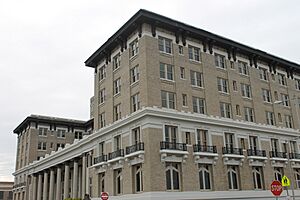
- Alexandria Memorial Gardens – a large cemetery.
- Alexandria Levee Park – a park downtown by the Red River. It hosts festivals and concerts.
- Alexandria Mall – the local shopping mall.
- Alexandria Riverfront Center – a convention center downtown.
- Bringhurst Field – former home of the Alexandria Aces baseball team.
- Bringhurst Park – has the Alexandria Zoo, Bringhurst Field, a playground, a golf course, and tennis courts.
- Hotel Bentley – a historic hotel built in 1908.
- Kent Plantation House – a French colonial plantation house.
- Rapides Parish Coliseum – a large arena for sports and other events.
Military Presence
Louisiana National Guard
Alexandria is home to parts of the 199th Brigade Support Battalion (BSB). This group helps the 256th Infantry Brigade with supplies, transportation, medical support, and maintenance.
England Air Force Base (Former)
Alexandria used to be home to England Air Force Base. It started as an emergency airstrip. The base closed in 1992. Now, it is the Alexandria International Airport.
Alexandria's Economy
In 2016, the average income per person in Alexandria was $23,962. This was a bit lower than the average for Louisiana. The city has about 55,000 workers.
New businesses have created jobs in the area. Union Tank Car Company opened a plant near the airport. The Procter & Gamble plant expanded. A PlastiPak plant was built in nearby Pineville. Sundrop Fuels Inc., a biofuels company, plans to build a large plant southwest of Alexandria.
In 2007, Inc. Magazine ranked Alexandria as the 77th best U.S. city for business. This was a big jump from its 2006 ranking.
Healthcare Services
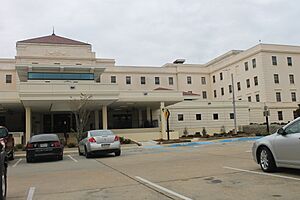
Alexandria has two main hospitals:
- Rapides Regional Medical Center, located downtown.
- Christus St. Frances Cabrini Hospital, opened in 1950.
Both hospitals have grown over time.
The Veteran's Affairs Medical Center in Pineville serves central Louisiana. In 2013, the state moved medical services from Huey P. Long Medical Center to England Park.
Port of Alexandria: A Hub for Goods
In the early 1800s, the Port of Alexandria brought goods to the area. It also shipped cotton and other local products. A ferry connected Alexandria and Pineville until a bridge was built in 1900.
Today, the Port has modern facilities. It has cranes, warehouses, and storage domes for different goods. It can handle oil and other cargo. Its central location and connection to the Mississippi River make it important for trade.
Alexandria International Airport
Alexandria International Airport (AEX) is a regional airport. It offers flights to Atlanta, Dallas/Ft. Worth, and Houston. A new passenger terminal opened in 2006. American and Delta serve Alexandria.
Military Use of the Airport
The airport used to be England AFB until 1992. Now, it is also used by international charter airlines. They transport military personnel to Fort Johnson. A new terminal for military personnel opened in 2007.
Learning in Alexandria
Colleges and Universities
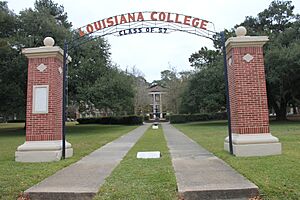
Louisiana State University at Alexandria (LSUA) is a regional campus of the Louisiana State University system. It started in 1959. For many years, it only offered two-year degrees. In 2002, LSUA was allowed to offer four-year degrees.
You can also get a four-year degree at Louisiana Christian University in Pineville. This university is connected to the Southern Baptist church and was founded in 1906.
Two campuses of Central Louisiana Technical Community College are also in Alexandria.
Schools for Kids and Teens
The Rapides Parish School Board runs the public schools.
Alexandria has three public high schools:
- Bolton High School
- Alexandria Senior High School
- Peabody Magnet High School
There are also two private high schools:
- Holy Savior Menard Central High School (Catholic)
- Grace Christian
Getting Around Alexandria
Roads and Highways
Alexandria is a major crossroads in Louisiana. If you want to go from the southern part of the state to Shreveport or Monroe, you usually drive through Alexandria. The same is true if you're going from northern Louisiana to the Cajun areas like Lake Charles or Lafayette, or to Baton Rouge or New Orleans.
I-49 goes through Alexandria. Other important highways include Louisiana 1, Highway 167, Highway 165, and Highway 71. These highways connect Alexandria to different parts of the state.
There are talks about building a new beltway around Alexandria and Pineville. There's also a plan for an East-West Interstate (I14) called the Gulf Coast Strategic Highway.
Bridges Over the Red River
Three road bridges cross the Red River in the Alexandria area:
- The Purple Heart Memorial Bridge: This bridge is part of the Alexandria-Pineville Expressway. It connects Interstate 49 to Highway 167. It has six lanes of traffic.
- The U.S. 165 Business Bridge (also called the Gillis Long Bridge or Jackson Street Bridge): This two-lane bridge connects downtown Pineville with Alexandria's business district. It has a sidewalk and bike path.
- The Curtis-Coleman (Fort Buhlow) Bridge: This new four-lane bridge opened in May 2016. It replaced the old OK Allen Bridge.
Former bridges include the Murray Street Bridge and the Fulton Street Bridge.
There are also two railroad bridges over the Red River in Alexandria.
Public Transportation
Public transportation in Alexandria is handled by ATRANS (Alexandria Transportation Authority).
If you're traveling by bus, Greyhound Lines has a station downtown.
Airports for Travel
Alexandria is served by the Alexandria International Airport and the Esler Regional Airport in Pineville.
Train Travel (Past)
Alexandria does not have Amtrak train service today. In the early 1900s, the Kansas City Southern and Missouri Pacific had train stations here. But passenger train services ended in the 1960s.
Nearby Cities and Towns
Images for kids
-
Scenic view of the Red River of the South taken from levee in Alexandria
-
Christmas chapel is a seasonal exhibit near Alexandria City Hall.
-
Former Missouri Pacific Railroad depot in downtown historic district
-
Lower view of Rapides Parish Courthouse in Alexandria
See also
 In Spanish: Alexandria (Luisiana) para niños
In Spanish: Alexandria (Luisiana) para niños



